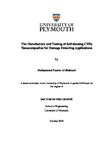The Manufacture and Testing of Self-Sensing CNTs Nanocomposites for Damage Detecting Applications
| dc.contributor.supervisor | Cree, Alistair | |
| dc.contributor.author | Al-Bahrani, Mohammed | |
| dc.contributor.other | School of Engineering, Computing and Mathematics | en_US |
| dc.date.accessioned | 2019-11-28T17:01:41Z | |
| dc.date.issued | 2019 | |
| dc.identifier | 10513712 | en_US |
| dc.identifier.uri | http://hdl.handle.net/10026.1/15207 | |
| dc.description.abstract |
Composite materials are widely used in various important applications due to their good engineering properties. However, these properties can be reduced when subjected to different type of loads. This thesis experimentally, theoretically and statistically investigates the possibility of using multi-walled carbon nanotubes (MWCNTs) as a filler to fabricate self-sensing nanocomposites for fracture and damage sensing applications. Self-sensing composite based MWCNTs can be used to diagnose early stage damage in order to prevent a fatal fracture that could occur in the structure during its working life. Here, different concentrations of MWCNTs were evenly distributed either in an epoxy resin using high frequency sonication or by depositing them onto the glass fibre surface to make it electrically conductive. Scanning electron microscopy (SEM) and Raman spectroscopy were used to investigate the presence of the MWCNTs and their interaction with the matrix. These self-sensing nanocomposites were subjected to different types of failure such as low velocity impact, static and cyclic compression test under varied temperature, anticlastic deformations including flexural and bending tests. During such testing the mechanical, electrical, impact damage, damage sensitivity, flexural, and piezoresistive properties were examined experimentally and statistically. The results of SEM microscopy showed that the MWCNTs were well distributed inside the matrix, although some agglomeration occurred at high MWCNTs concentrations. Moreover, electrical conductivity measurements indicated a steadily increasing directly proportional relationship with increasing the MWCNTs concentration. In addition, the observed changes in the electrical resistance of specimens increased with increasing impact energy, and temperature. Conversely, the resistance decreased with increasing compression loads, and during flexural and anticlastic testing up to a certain level and then increased due to specimen distortion. In terms of the strain sensitivity, there are two strain sensitivities, in opposite directions obtained, during anticlastic testing and only one obtained under flexural and compression testing conditions. This study has confirmed that the properties of a self-sensing composite are strongly dependent on the method used to deposit the MWCNTs onto the surface of glass fibres layers, the types of test, deformation after testing and the operative test conditions (i.e. temperature). Given these results, it is possible to correlate the degree of damage incurred due to the external loads with the changes in electrical resistance of the MWCNTs-GE nanocomposites both during, and after, loading. Therefore, this type of self-seing nanocomposites shows excellent potential for use in many strain and fracture sensing applications. | en_US |
| dc.language.iso | en | |
| dc.publisher | University of Plymouth | |
| dc.subject.classification | PhD | en_US |
| dc.title | The Manufacture and Testing of Self-Sensing CNTs Nanocomposites for Damage Detecting Applications | en_US |
| dc.type | Thesis | |
| plymouth.version | publishable | en_US |
| dc.identifier.doi | http://dx.doi.org/10.24382/559 | |
| dc.rights.embargodate | 2020-11-28T17:01:41Z | |
| dc.rights.embargoperiod | 12 months | en_US |
| dc.type.qualification | Doctorate | en_US |
| rioxxterms.version | NA |
Files in this item
This item appears in the following Collection(s)
-
01 Research Theses Main Collection
Research Theses Main


